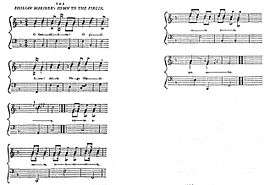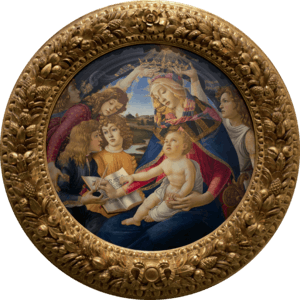O Sanctissima
"O Sanctissima" ("O Most Holy") is a Roman Catholic hymn in Latin, seeking the prayers of the Blessed Virgin Mary, and often sung in various languages on her feast days. The earliest known publication was from London in 1792, presenting it as a traditional song from Sicily; but no original source or date has been confirmed for the simple melody or the poetic text. The tune is often called "Sicilian Mariners Hymn" or similar titles, referring to the seafarers' nightly invocation of Mary as their maternal protector:[1] Our Lady, Star of the Sea. The tune has been notably reused for the German Christmas carol "O du fröhliche" ("O, how joyfully"), the English recessional hymn "Lord, Dismiss Us With Thy Blessing", and the first half of the American civil rights anthem "We Shall Overcome".
Similar Latin lyrics have been set to entirely different tunes since the 1500s, by notable composers and arrangers including Leonhard Kleber (probably editing another composer), Louis-Nicolas Clérambault, E.T.A. Hoffmann, Antonín Dvořák, and Fritz Kreisler (using a melody of Arcangelo Corelli).
Latin lyric and English translation
Below is a common version of the text; many other versions exist.
O sanctissima, o piissima, |
O most holy, o most loving, |
An 1820 book claims, without verification, that the first lines of the Latin text were already engraved at Speyer Cathedral at the time of Saint Bernard of Clairvaux (1090–1153).[2]
Widening circulation

After being published anonymously by European Magazine in 1792[1] and then by an American magazine in 1794,[3] by the early 1800s "O Sanctissima" was spreading widely in multiple languages. J.G. Herder included the song posthumously in his prominent book of traditional folksongs (Stimmen der Völker in Liedern, 1807),[4] while Haydn (Hob. XXIIIc:F2)[5] and Beethoven (WoO 157:4)[6] each wrote choral arrangements of the Latin hymn. A German-language version ("O du fröhliche", c.1816)[7] became a well-known Christmas carol, with original lyrics by J.D. Falk referring not to the Blessed Virgin Mary, but rather to Jesus himself and his day of birth. In English:
O, how joyfully; O, how merrily
Christmas comes with its grace divine.
Grace again is beaming; Christ the world redeeming.
Hail, ye Christians, hail the joyous Christmas time!
Or, in another English-language rendition:
O thou happy, O thou holy,
Glorious peace bringing Christmas time.
Angel throngs to meet thee; on Thy birth we greet Thee:
Hail to Christ, the Son of God, our newborn king!
By 1835, the tune (with its first half repeated) also came to be used for the English recessional hymn "Lord, Dismiss Us With Thy Blessing",[8] and by 1945 it appears to have influenced the melody of the American civil rights anthem "We Shall Overcome", with a close match between the first half of both tunes.[9][10][11]
References
- 1 2 Seward, William (November 1792). Reed, Isaac, ed. "Drossiana. Number XXXVIII. The Sicilian Mariner's Hymn to the Virgin". European Magazine and London Review. 22 (5): 342, 385–386. Retrieved 25 October 2016.
Travellers all agree in their account of the effects of the simple air called 'The Virgin's Hymn,' sung in unison by the whole crew of the Sicilian seamen on board their ships when the sun sets, or when it is the twenty-fourth hour of Italy.
The editor identified the article's author in his obituary: Reed, Isaac, ed. (October 1799). "William Seward, Esq.". European Magazine and London Review. 36 (4): 219–220.William Seward... amused himself with collecting the materials for what he called Drossiana in the present Magazine; which he began in October 1789, and continued without intermission to the end of his life.
- ↑ Grimm, Ferdinand Philipp "Lothar", ed. (1820). "Das redende Marienbild zu Speier". Volkssagen und Märchen der Deutschen und Ausländer. p. 90. Retrieved 20 November 2016.
- ↑ Shaw, Robert, ed. (May 1794). "Prayer of the Sicilian Mariners". The Gentleman's Amusement: 25. Retrieved 18 October 2016.
- ↑ Herder, Johann Gottfried (1807). "An die Jungfrau Maria: Ein sizilianisches Schifferlied". Stimmen der Völker in Liedern. pp. 175–176. Retrieved 18 October 2016.
- ↑ "Franz Josef Haydn Catalogue: XXIII". Musique et Musiciens. Retrieved 15 October 2016.
- ↑ "Ludwig van Beethoven Catalogue: WoO". Musique et Musiciens. Retrieved 15 October 2016.
- ↑ Parent, Ulrich; Rossler, Martin (2002). "O du fröhliche". In Hahn, Gerhard; Henkys, Jürgen. Liederkunde zum Evangelischen Gesangbuch. 4. pp. 26–30. Retrieved 15 October 2016.
- ↑ Mason, Lowell; Mason, Timothy B., eds. (1835). The Sacred Harp or Eclectic Harmony. p. 131. Retrieved 15 October 2016.
- ↑ Brink, Emily; Polman, Bert, eds. (1988). The Psalter Hymnal Handbook. Retrieved 26 January 2015.
- ↑ Wallechinsky, David; Wallace, Irving, eds. (1978). The People's Almanac #2. pp. 806–809. Retrieved 26 January 2015.
- ↑ Bobetsky, Victor V. (2015). We Shall Overcome: Essays on a Great American Song. pp. 1–4. Retrieved 3 March 2015.
External links
| Wikimedia Commons has media related to O Sanctissima. |
- "O Sanctissima" on YouTube, The Cathedral Singers, Richard Proulx

